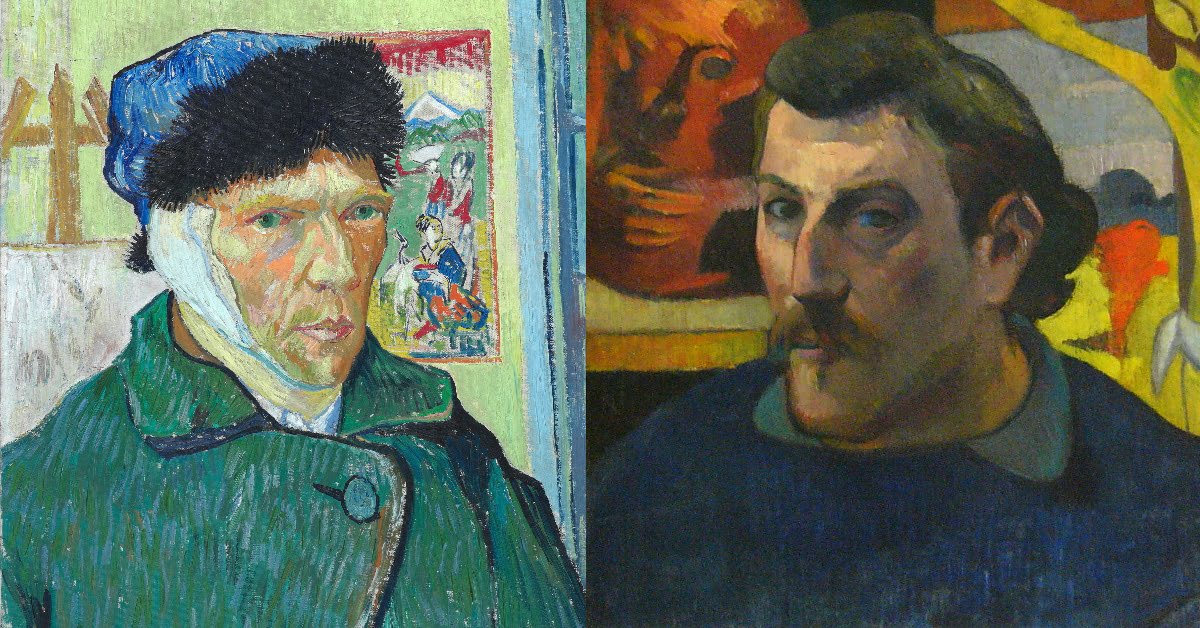According to a common version, the famous Dutch artist did not cut off his ear himself, but lost it in a fight with his French colleague. We checked how plausible this version is.
It was traditionally believed that mentally ill Vincent van Gogh cut off his ear with a razor in the French town of Arles in 1888. However, in 2008 a book by German professors Hans Kaufmann and Rita Wildegans was published "Van Gogh's Ear: Paul Gauguin and the Vow of Silence", which instantly became a bestseller. The authors, art historians, as a result of a large-scale investigation, came to the conclusion that Gauguin cut off Van Gogh’s ear with a rapier when they fought at the entrance to a brothel. Van Gogh then wrapped his ear in a rag and gave it to a prostitute named Rachel - in this part the canonical and new versions of the development of events coincide. Further, according to the researchers, both artists - each for their own personal reasons - chose not to mention this incident.
The theory has found widespread acceptance in world And Russian The media, partially replacing the canonical version of Van Gogh’s loss of his ear in the mass consciousness.
Paul Gauguin arrived in the Provençal city of Arles to visit his friend Van Gogh in October 1888. The Dutchman was very glad that he will spend the winter in the company of a friend. “It seems to me that if I find another artist who wants to develop the theme of the south and, like me, is so absorbed in his work that he agrees to live like a monk, visiting a brothel once every two weeks, and the rest of the time not to stop working and not waste time, then everything will work out perfectly. I’m alone here and I’m a little sad alone,” wrote he, inviting the Frenchman to his place. Especially for Gauguin’s arrival, Van Gogh created a series of paintings, among which are works such as “The Yellow House” and “The Poet’s Garden.” However, Gauguin soon became disillusioned with his untidy and disorganized friend and had difficulty getting along with him under the same roof. "Firstly, - wrote he subsequently - I found disorder everywhere, which amazed me. His paint drawer could barely hold all the tubes he started, which he never closed; yet, despite all this chaos, this jumble, there was something brilliant in his canvases, and in his speeches too. His Dutch head was inflamed by the Bible, Daudet, Goncourt. The embankments, bridges and boats in Arles, in short, the south, replaced his native Holland. He even forgot how to write in Dutch... From the very first month I saw that our common finances were in the same mess.” Van Gogh in his letter to his brother Theo too didn't hide, that everything was not going very smoothly: “Our discussions are electrified to the limit, and after them we sometimes feel as empty as a discharged electric battery.”
One of the common activities of the two artists was their semi-work trips to brothels. “We've made a few trips to the fun house and we'll probably end up getting used to working there. Gauguin is currently busy with a canvas depicting a night cafe, which I also painted; but he introduced into the picture the figures he saw in the brothel. The thing promises to be very beautiful,” Van Gogh reported on November 1–2, 1888 in his letter Emile Bernard, a mutual friend of the two artists.
What happened a few weeks after writing this rather optimistic letter? Historically, it was believed that on December 23, after another series of quarrels with a colleague, Paul Gauguin went for an evening walk. Hearing footsteps behind him, he turned around and saw Van Gogh with an open razor in his hand. Under Gauguin's gaze, Van Gogh turned around and left. The frightened Frenchman spent the night in a city hotel, and the Dutchman went home and used the same razor to cut off a piece of his ear, put it in an envelope and took it to the nearest brothel. There he handed the envelope to a prostitute he knew, Rachelle, who fainted when she saw the contents of the envelope. Van Gogh returned home, where the police found him the next morning and took him to the city hospital. In memory of this incident, two self-portraits of Van Gogh with a bandaged ear remained to humanity: with tube And without her.
According to Kaufman and Wildegans, Gauguin left the yellow house on Place Lamartine on December 23 with his things to spend the night in a hotel and leave Arles the next morning. The artist, who was keen on fencing, had among his belongings a rapier, which, unfortunately, came in handy here. The quarrel broke out again, and Gauguin, trying to keep the Dutchman at a distance, either in rage, or accidentally cut off his earlobe. Fearful of responsibility, Gauguin threw the rapier into the Rhone River.
What evidence do the authors of the study rely on? In fact, there are three of them. Firstly, on one of sketches Gauguin's ear is inscribed with the Latin word ictus ("strike"), used by fencers.
Secondly, in one of his last letters to Van Gogh, the Frenchman requires return his fencing mask and gloves left in the yellow house. From this, Kaufman and Wildegans conclude that Gauguin took the rapier with him, at least from home. Finally, it's up to us arrived the phrase addressed to a Frenchman: “You are silent. I too will be silent,” which scientists consider evidence of a vow of silence.
However, if we talk about the world of professional researchers of Van Gogh’s work, then the version of Kaufmann and Wildegans cannot be called dominant in it. First, the theory is based on chains of assumptions and guesses. If the story with the razor is confirmed by diaries (including Gauguin), then the version with the rapier was built almost from scratch. For example, why Gauguin did not take back all his fencing equipment (but did not forget about the foil), the researchers do not explain. The most authoritative Van Gogh Museum in Amsterdam and today, more than a decade after the publication of the book by two Germans, insists on the version about self-harm and a razor (called a knife on the site).
In addition, in 2013, new details of the famous incident became known. Their discovered researcher Martin Bailey, author of My Sunflowers: The Story of Van Gogh's Masterpiece. The scientist found the first mention of this case in the press. A telegram from a special correspondent from Arles dated December 24, 1888 was published on December 26 in the Paris edition of Le Petit Journal and contained the following text: “Yesterday evening a certain artist from Holland named Vincent, after cutting off his ear with a blade, came to the door of a brothel and gave a piece of his ear, wrapped in paper, to the man who opened the door. “Take this, it might be useful,” he said and left. Police later found the man lying in his home. His condition required immediate transfer to the hospital.” As Bailey suggests, the artist was already suffering from a long-term mental illness at that time.
In 2016, researcher Bernadette Murphy discovered a note with a drawing, from which it follows that Van Gogh cut off not his earlobe, as is usually believed, but his entire ear. The document is dated 1930, and its author, Dr. Felix Rey, worked in the Arles hospital in the winter of 1888-1889 and spent a lot of time with the recovering artist. In addition, Murphy identified the prostitute who was given the ear as Gabrielle Berlatier.
Thus, most of the facts indicate that the version of Gauguin cutting off Vincent Van Gogh’s ear with a rapier should be considered exotic and unlikely.
Most likely not true
Read on the topic:
1. Van Gogh's words after cutting off his ear revealed
2. Who did Van Gogh give his ear to?
3. Van Gogh. Letters.
If you find a spelling or grammatical error, please let us know by highlighting the error text and clicking Ctrl+Enter.







